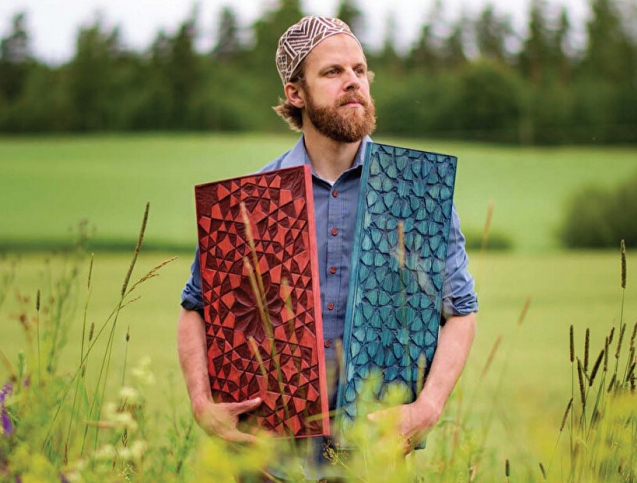Let’s start by getting to know you. Could you tell us briefly about yourself? I heard that your family has three generations of carpenters.
My name is Mats Cederberg, and I also took the name Abdelkarim, which means the servant of the most Generous. I was born and raised in Mora, Sweden, a place renowned for preserving traditions, folk music, folk costumes, crafts, and traditional building techniques. Both my parents are fiddlers, teachers, and artists. My father is a leading expert on bumblebees and insects in Europe. His elegantly carved spoons and bowls, along with his exquisite entomological drawings, and my mother’s flowing calligraphy, watercolours, and doodling, have been a great inspiration for me. As a child, I attended craft evenings at the school where my father taught, where everyone gathered to carve spoons or learn old techniques in various crafts. I still use chisels and knives that I got from my grandfather and some that were forged by my ancestors several generations ago.
How can converted Muslims synthesise the culture they come from and Islamic art? What should we understand from the concept of Scandinavian Islamic Art? What kind of opportunities does Scandinavian culture offer to your work?
Islam is not culturally predatory and encourages pride in one’s heritage without arrogance or bullying. Cultural diversity should be celebrated, and Islamic spirituality resonates universally, appreciating all that is good and beautiful, wherever it is found. Islamic art is about unity and multiplicity. I draw inspiration from artefacts from the Vendel- and Viking Age, and the Swedish forest and nature. I often use traditional pigments and materials that I prepare myself.
Could you tell us the story of the “Old Norse mihrab” you made? There was a speech made in front of it by King Charles.
I saw the portal of a thousand year old Norwegian stave church with intricate wood carving and felt compelled to create a mihrab like that. It incorporated biomorphic patterns resembling Seljuk and Turkic motifs but on a larger scale than typical Islamic art. Years later, it materialised as an MA project at The Prince’s School of Traditional Arts. It was a long process and I spent a lot of time researching designing and redesigning the motifs and carved motifs in the cherry wood by hand. King Charles gave a speech in front of it at our exhibition, expressing genuine interest and appreciation for it and other exhibits. It is now installed in a mosque in Malmö Sweden.
The primary objective of the mihrab is to direct the worshipper to prayer, remembrance and mindfulness. The mihrab also has to seamlessly assimilate into the structural and aesthetic dictates of the building’s measurements and proportions as well as the material and symbolic language of its ornamentations. Underlying the decisions behind the design are my intentions of expressing both islamic- and Scandinavian aesthetics. I wanted to tap into both the old norse tradition and the later soberer church portals of that area as well as the muslim aesthetics so that it resonates with many different people and that it is not foreign nor alien to its context.
You also have work in calligraphy and other fields. I know you are interested in art therapy. Could you tell us a little about these works?
I studied calligraphy with a master in Damascus in the early 2000s, and since then, I’ve experimented with methods and materials, studying old manuscripts and calligraphic compositions. I’ve explored square Kufic and Andalusian scripts, I find them more playful and less rigid than the Ottoman styles (that I also deeply appreciate).
I’ve also organised retreats together with other artists and experts on islamic psychology, focusing on the healing aspects of sacred art. These retreats involve exploring classic Islamic patterns, symbols, and sacred proportions in the cosmos. Engaging with artistic media and the creative process opens doors to self-exploration, facilitating healing and well-being.
